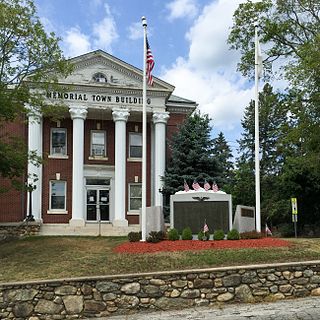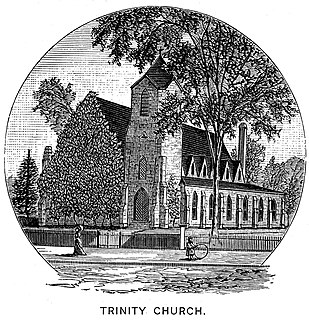
The Roman Catholic Diocese of Providence is a diocese of the Catholic Church in the United States. The diocese was erected by Pope Pius IX on February 17, 1872 and originally comprised the entire state of Rhode Island and the counties of Bristol, Barnstable, Dukes and Nantucket in the state of Massachusetts. On March 12, 1904, those four counties were separated from the Diocese of Providence to form the Diocese of Fall River, Massachusetts, leaving the Diocese of Providence with just the state of Rhode Island.

The Cathedral of St. Joseph in Hartford, Connecticut, United States, is the mother church and seat of the Archdiocese of Hartford. Dedicated on May 15, 1962, it stands on the site of the old cathedral which had been destroyed in a fire. It is located on Farmington Avenue just outside downtown Hartford.

Bishop Thomas Francis Hendricken served as the first Roman Catholic Bishop of Providence, Rhode Island.

The Episcopal Diocese of Rhode Island is a diocese of the Episcopal Church in the United States of America, encompassing the state of Rhode Island. It is one of seven New England dioceses that make up Province 1.

The Cathedral of Saints Peter and Paul is a Roman Catholic cathedral in the Cathedral Square neighborhood of Providence, Rhode Island, United States. It is the mother church of the Diocese of Providence. The Neo-Romanesque church was designed in 1873 by Patrick Keely and added to the National Register of Historic Places in 1975.

Russell Warren (1783–1860) was an American architect, best known for his work in the Greek Revival style. He practiced in Bristol and Providence.

Slatersville is a village on the Branch River in the town of North Smithfield, Rhode Island, United States. It includes the Slatersville Historic District, a historic district listed on the National Register of Historic Places. The historic district has been included as part of the Blackstone River Valley National Historical Park. The North Smithfield Public Library is located in Slatersville.

St. Ambrose Cathedral is a historic building located in downtown Des Moines, Iowa, United States. It serves as a parish church and as the seat of the Diocese of Des Moines in the Catholic Church. The cathedral, along with the adjoining rectory, was listed on the National Register of Historic Places in 1979.
Edward Tuckerman Potter was an American architect best known for designing the 1871 Mark Twain House in Hartford, Connecticut. With his half-brother William Appleton Potter, he also designed Nott Memorial Hall (1858–79) at his alma mater, Union College, Schenectady, New York. Both the Mark Twain House and Nott Memorial Hall are National Historic Landmarks.

S. Stephen's Church is an historic Episcopal church located at 114 George Street in the College Hill neighborhood of Providence, Rhode Island. Located in the midst of the Brown University campus, it is an active parish in the Episcopal Diocese of Rhode Island, with a strong Anglo-Catholic identity.

Grace Church is an historic Episcopal church at 300 Westminster Street at Mathewson Street in downtown Providence, Rhode Island. It was built in 1845-46 and was designed by Richard Upjohn in the Gothic Revival style.

St. Michael's Roman Catholic Church, Convent, Rectory, and School is an historic Roman Catholic church complex at 251 Oxford Street in Providence, Rhode Island within the Diocese of Providence.

Trinity Episcopal Church was a historic church located at 48 Main Street in Pawtucket, Rhode Island. Built by the Episcopalians, the building was sold to the Catholics in 1977 and became the St. George Maronite Catholic Church within the Diocese of Providence. The church burned down in 2005, and was not rebuilt.
Russell Joseph McVinney was an American prelate of the Roman Catholic Church. He served as Bishop of Providence from 1948 until his death in 1971.
William Augustine Hickey was an American prelate of the Roman Catholic Church. He served as Bishop of Providence from 1921 until his death.

Clifton A. Hall (1826-1913) was an American architect from Providence, Rhode Island.

John Holden Greene (1777-1850) was a noted early nineteenth century architect practicing in Providence, Rhode Island. The bulk of his work dates to the late Federal period, and is mostly in the architectural style of the same name. Greene is responsible for the design of over fifty buildings built in the city between 1806 and 1830, almost half of which are still standing.

Alpheus C. Morse (1818-1893) was an American architect with offices in Providence, Rhode Island.

Wallis Eastburn Howe (1868–1960) was a notable American architect from Rhode Island.
John Seville Higgins was bishop of the Episcopal Diocese of Rhode Island, serving from 1953 to 1954 as coadjutor and from 1955 to 1972 as diocesan.





















